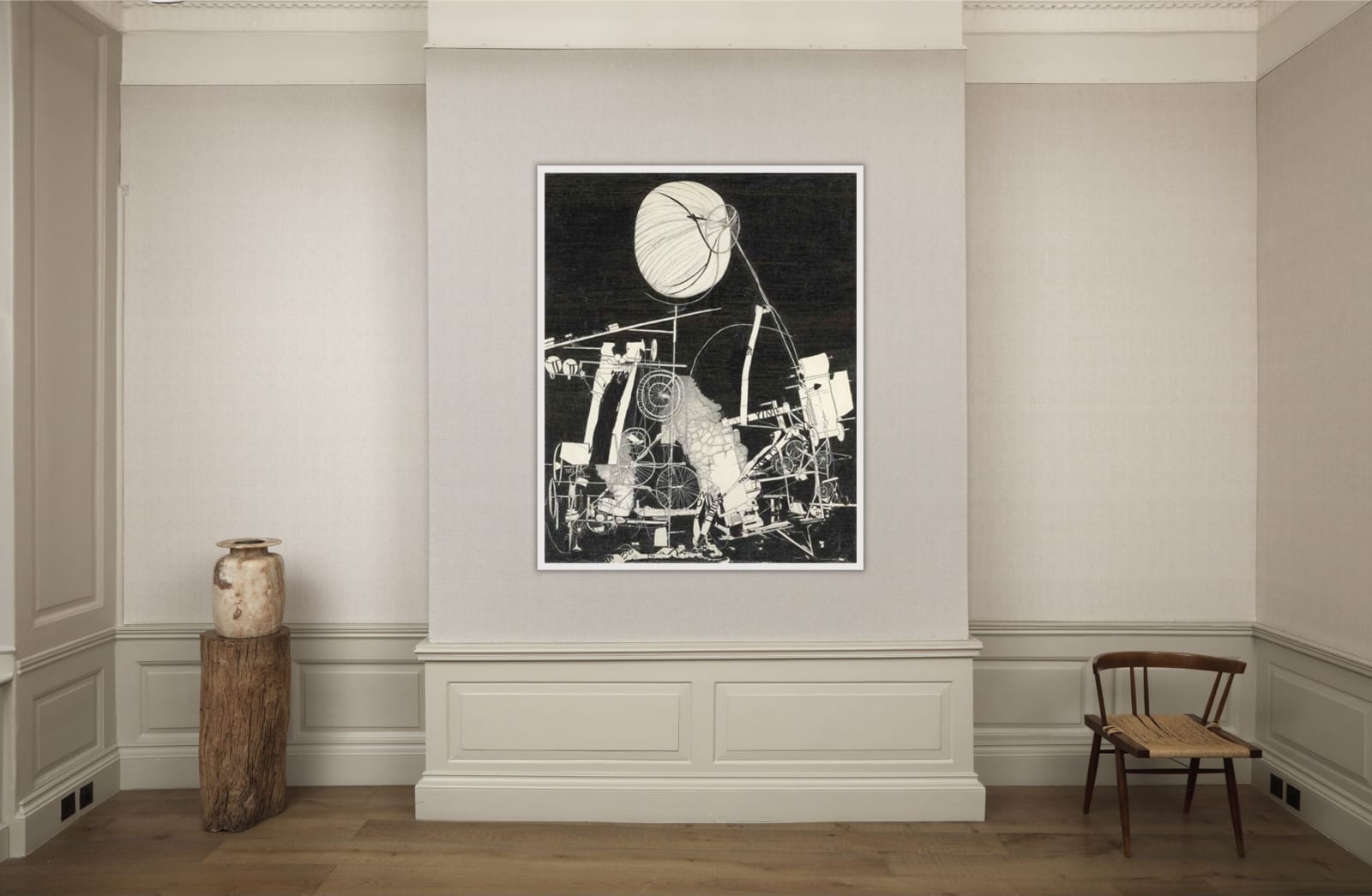Michael Landy b. 1963
H2NY Interrupted Climax, 2007
oilstick on paper
60 x 48 inches
152.4 x 121.9 cm
152.4 x 121.9 cm
signed and dated
Michael Landy visited Jean Tinguely’s Tate Gallery retrospective as a student in 1982. H2NY Interrupted Climax, is one of a series of drawings based on Tinguely's self-destructing sculpture, Homage to...
Michael Landy visited Jean Tinguely’s Tate Gallery retrospective as a student in 1982. H2NY Interrupted Climax, is one of a series of drawings based on Tinguely's self-destructing sculpture, Homage to New York, 1960. Tinguely built his infamous machine in the garden of the Museum of Modern Art over three weeks in March 1960. It was set in motion for 27 minutes on 17 March. The machine spasmed and shook but failed to self-destruct fully, and some parts caught fire forcing a fireman and two museum guards to intervene.
During 2006-7, Landy made 168 drawings on the subject using charcoal, oil-stick, correction fluid, bleach, glue and ink. Every drawing displays Landy's meticulous draftsmanship, but they vary in their depiction of the event. In some, Landy renders the minute details of Tinguely's machine; others are less precise to better convey the explosive chaos of the machine's breakdown. Landy's drawings are based on black and white archive photographs and video, which show the machine lit up against a dark background. (1) The experimental drawing methods he uses – bleaching, scraping away and whiting out – themselves refer to the theme of destruction and removal. Here Landy uses a quasi-sculptural technique where he covers the paper in black oil-stick before overlaying with white and then carving into the surface to reveal the black beneath.
Tinguely found many of the materials for his machine at rubbish dumps, junk shops and army surplus stores. They included electric motors, radios, smoke signals, saws, an American flag, an upright piano, around eighty bicycle and pram wheels and a meteorological balloon. The final machine extended 27 feet in height. One part was based around a giant painting machine that unfurled a roll of paper down a metal trough, where it was attacked by two large brushes. The second part centred around the piano, which was struck by moving bicycle parts, and which also included a second painting machine and unravelling streamers of text. The steel tubing that formed the structure was cut and welded back together so the joints would melt and collapse when an electrical current was applied.
The themes of failure and destruction run through many of Landy's projects. His 2001 installation, Break Down, presented the systematic destruction of all his possessions in a closed-down department store. At the beginning of 2010, he asked artists to bring their failed artworks to his giant Art Bin at the South London Gallery, and in the autumn he invited visitors to the Frieze art fair to use his Credit Card Destroying Machine.
(1) Because the performance was scheduled for early evening, Tinguely had at the last minute decided to paint the entire machine white. For a detailed account of the performance see Calvin Tomkins, Ahead of the Game, Four Versions of the Avant-Garde, Penguin, Harmondsworth, Middlesex, 1968, pp158-174
During 2006-7, Landy made 168 drawings on the subject using charcoal, oil-stick, correction fluid, bleach, glue and ink. Every drawing displays Landy's meticulous draftsmanship, but they vary in their depiction of the event. In some, Landy renders the minute details of Tinguely's machine; others are less precise to better convey the explosive chaos of the machine's breakdown. Landy's drawings are based on black and white archive photographs and video, which show the machine lit up against a dark background. (1) The experimental drawing methods he uses – bleaching, scraping away and whiting out – themselves refer to the theme of destruction and removal. Here Landy uses a quasi-sculptural technique where he covers the paper in black oil-stick before overlaying with white and then carving into the surface to reveal the black beneath.
Tinguely found many of the materials for his machine at rubbish dumps, junk shops and army surplus stores. They included electric motors, radios, smoke signals, saws, an American flag, an upright piano, around eighty bicycle and pram wheels and a meteorological balloon. The final machine extended 27 feet in height. One part was based around a giant painting machine that unfurled a roll of paper down a metal trough, where it was attacked by two large brushes. The second part centred around the piano, which was struck by moving bicycle parts, and which also included a second painting machine and unravelling streamers of text. The steel tubing that formed the structure was cut and welded back together so the joints would melt and collapse when an electrical current was applied.
The themes of failure and destruction run through many of Landy's projects. His 2001 installation, Break Down, presented the systematic destruction of all his possessions in a closed-down department store. At the beginning of 2010, he asked artists to bring their failed artworks to his giant Art Bin at the South London Gallery, and in the autumn he invited visitors to the Frieze art fair to use his Credit Card Destroying Machine.
(1) Because the performance was scheduled for early evening, Tinguely had at the last minute decided to paint the entire machine white. For a detailed account of the performance see Calvin Tomkins, Ahead of the Game, Four Versions of the Avant-Garde, Penguin, Harmondsworth, Middlesex, 1968, pp158-174
Provenance
Thomas Dane Gallery, London
Private Collection, UK
Exhibitions
Michael Landy, Everything Thing Must Go!, Ridinghouse/ Karsten Schubert, London, 2008, illus colour, p.372
Join our mailing list
* denotes required fields
We will process the personal data you have supplied to communicate with you in accordance with our Privacy Policy. You can unsubscribe or change your preferences at any time by clicking the link in our emails.



